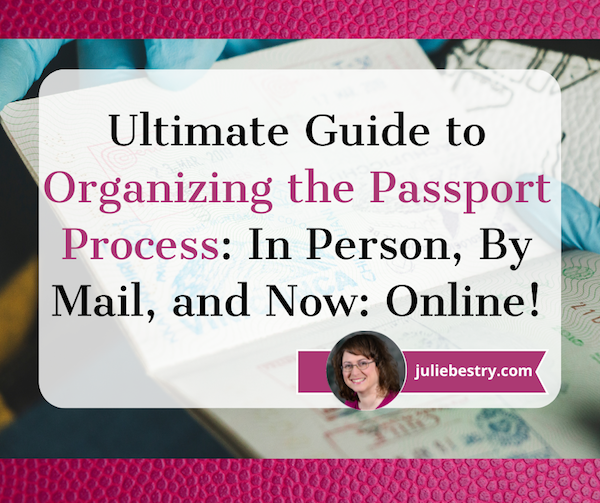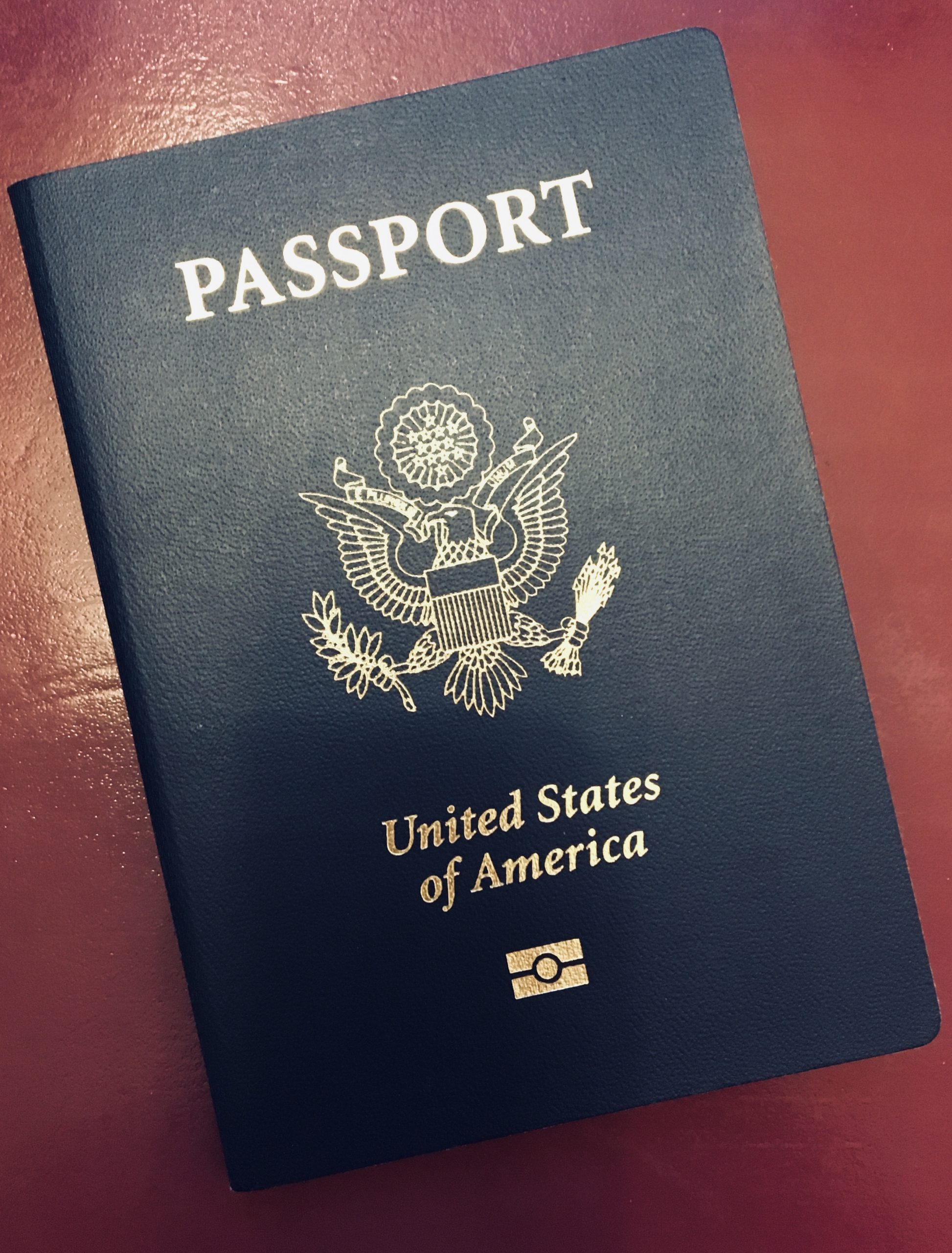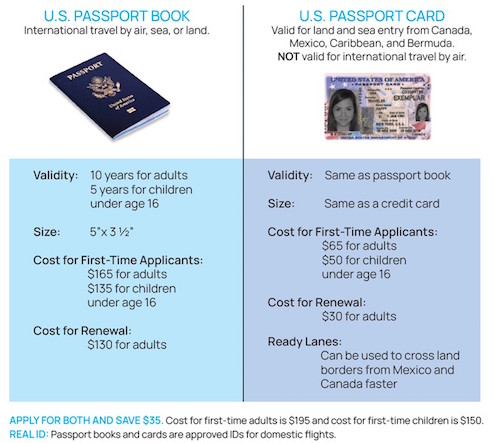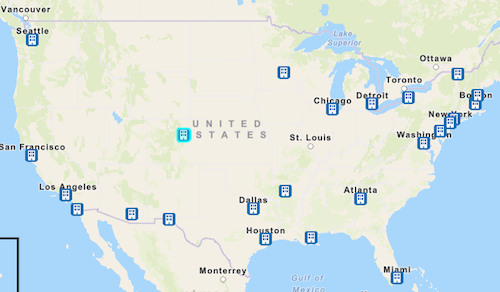Ultimate Guide to Organizing the Passport Process: In Person, By Mail, & Now: Online!

If you’re organized in approaching the experience, travel can broaden the horizons and delight the senses, as I have talked about in posts like:
- Paper Doll’s 5 Essential Lists For Planning an International Vacation
- Paper Doll on the Smead Podcast: Essential Lists For Organized Travel
- Paper Doll Organizes Your Space, Money, and Well-Being While Traveling
Of course, one large part of international travel is having an up-to-date passport, which I covered dating all the way back to 2010, when I wrote “May We See Your Papers?”: Passport Cards and Trusted Travelers. As you can imagine, a lot has changed since then.
And, in fact, a lot has changed in the world of passports as recently as last month! But first, let’s start with the basics.
THE GROWTH IN PASSPORT POPULARITY
In 1990, only 4% of citizens of the United States held passports. This was consistently a shock to Europeans, where international travel between nations was common. Certainly some of this was due to the immensity of the United States, per the old joke:
Texan: “I’m from the great state of Texas. My state is so big that you can get on a train, ride for a day and a night, and still be in Texas!”
Rhode Islander: “We used to have trains like that in Rhode Island.”
However, our expanse of land is not the only reason many Americans didn’t feel the need for a passport. Prior to 9/11, we Americans traveled in a much less restricted way. However, when the Intelligence Reform and Terrorism Prevention Act came into effect in January 2007, the law required U.S. citizens to have valid passports when traveling by air between the United States and Canada, Mexico, Central and South America, the Caribbean, and Bermuda.
Previously, traveling (by land, sea, or air) to these areas was fairly easy and required no passports. (Indeed, having grown up in Buffalo, I recall the many times my family or friends would dive to Canada for the day or even just for dinner, needing only to tell the customs officer our location of birth and whether we had anything to declare.)

US Department of State, Census Bureau, Haver Analytics, Apollo Chief Economist
Over the course of decades, the number of American citizens holding passports has continued to rise. Back in 1997, only 6.3 million U.S. passports were issued; in 2017 the State Department issued a record 21.4 million passports. Now, 48% of U.S. citizens, just slightly less than half, hold valid passports.
Unfortunately, I have no statistics on how many people leave for the airport having forgotten their passports.
BENEFITS OF HOLDING A PASSPORT
Holding a valid U.S. passport comes with a number of benefits beyond having a photo that rivals your driver’s license pic as being one of the least appealing shots ever taken of you.

A passport isn’t just a nifty little book for getting pretty stamps. It’s an essential document that facilitates domestic and international travel, and serves as a crucial form of identification and proof of citizenship. In particular, a U.S. passport comes with additional benefits, including:
Visa-Free Travel — Your U.S. passport allows you visa-free or visa-on-arrival access to much of the world, making international travel easier and more convenient. In fact, current holders of a United States passport may travel to 188 (of 193) countries and territories without a travel visa, or with a visa-on-arrival.
Consular Protection and Services — In case of emergencies (like loss of one’s actual passport, natural disasters, legal issues, etc.), U.S. citizens can receive assistance from U.S. embassies and consulates around the world.
Global Entry Program —U.S. passport holders can apply for Global Entry, which expedites customs processing when you return home, saving time navigating airport lines.
Ease of Travel to U.S. Territories — Your U.S. passport lets you travel seamlessly to U.S. territories such as Puerto Rico, Guam, and the U.S. Virgin Islands. No, you don’t have to have a passport to travel to these locations — because they are part of the United States — but having a U.S. passport makes it much easier to travel to territories without any additional documentation.
HOW TO APPLY FOR A PASSPORT
Let’s assume you’re an adult applying for your own passport for the first time. (If you’re seeking a first-time passport for a child under the age of 16, the rules are different.)
Gather Required Documents
This is where being organized comes in handy. Gather the following documentation:
- Proof of Citizenship — Usually, a certified birth certificate will suffice, but if you weren’t born in the United States, you’ll need a Consular Report of Birth Abroad (CRBA), a Certificate of Naturalization, or a Certificate of Citizenship.
- Proof of Identity — No, a note from your mother will just not do. Be prepared to show a valid driver’s license, government ID, or a military ID, and bring a photocopy, too.
- Passport Photo — Your latest Instagram selfie may be gorgeous, but you’ll need a passport photo that meets specific requirements: 2″ x 2″, in color, taken within the last six months, with a white or off-white background. You also aren’t allowed to smile! There are apps to help you, but if you’re a member of AAA, I encourage you to get your photo taken there. I’m a “blinker” and the nice ladies at AAA put up with SO MUCH blinking until we secured a decent photo.
Missing any of these essential documents? Check out my post How to Replace and Organize 7 Essential Government Documents.
Fill Out Form DS-11
- Fill out Form DS-11 online using the Department of State’s form filler or download a PDF and print it. Alternatively, pick up a paper copy from a passport acceptance facility or any U.S. post office. The DS-11 lets you apply for a passport book, a passport card*, or both. If you think there’s a chance that you’ll be traveling a lot (did you win an around-the-world trip?), request a larger passport book with more visa pages. Just check the large book box at the top of the DS-11 form; there’s no extra charge.
- DON’T SIGN THE FORM until instructed to do so at the passport acceptance facility. Seriously, do not sign the form or you’ll have to start all over.
*A passport card is a wallet-sized, plastic passport (so it has no visa pages) that serves as proof of your United States citizenship and identity, with the same length of validity as the passport book. However, it’s not valid for international travel by air; you can only use it to travel by land or sea between the United States and Canada, Mexico, Bermuda, and Caribbean countries.

Submit Your Application in Person
- Visit a passport acceptance facility in person. Depending on your location, this may be a post office, library, or other designated location, with official staff for handling passport acceptance. The Department of State has a search page; put in your zip code to find the closest options for your needs. If your travel is urgent and in the next three weeks, make an appointment at a passport agency location.
- Bring everything (the completed Form DS-11, proof of citizenship, proof of identity, passport photo, and the required fees (check or money order, only)) with you to the passport acceptance facility.
(There are also special passport acceptance fairs for processing new passports, but mostly only in New Jersey and Georgia.)
Pay the Fees
- As of the latest update, the total cost for a first-time adult passport book is $165 ($130 application fee to the U.S. Department of State and a $35 execution fee to whatever facility takes your application); for a passport card, it’s $65 ($30 application fee, $35 execution fee); for both, it’s $195 ($160 application fee, $35 execution fee).
- For expedited service (see below for details), add $60 to your application fee; add the weirdly specific $21.36 to your application fee if you want your completed passport shipped 1-2 days after issuance.
- Check the current fee schedule, as fees can change over time.
Wait for Processing
- Enroll in email updates to track your passport’s status.
Have your eyes glazed over while reading this? Perhaps a video is more your style.
RENEW YOUR PASSPORT THE TRADITIONAL WAY: BY MAIL
This is all well and good, but what if you’ve had a passport forever, or applied for one the first time you ever read a Paper Doll post about passports, but now need to renew?

Mailboxes by EraserGirl licensed under the Creative Commons Attribution 2.0 Generic license
Well, the simple act of renewing your passport was never particularly simple (or swift). The traditional method of renewing your passport by mail still requires the following steps:
Make sure you meet the renewal requirements
- You must have your old, undamaged passport in your possession so you can mail it in — The problem? If you travel frequently for work or your personal life, you might have had to cancel trips because you would not have (or would not know if you’d have) your passport back in time.
- The passport had to have been issued within the last 15 years to you when you were at least 16 years of age. — The problem? If a college student has to renew a passport received as a child. It’s not always easy for college-age people to accomplish all the steps to renew their passports, as they’ll likely have to get their original documents from their parents, get themselves somewhere to take an acceptable passport photo, and get to a location that helps with passport renewals by mail.
- The passport must have been issued in your current name unless you can provide, by mail, a document like a marriage certificate, divorce decree, or court order showing a change of name to affirm gender. (For more on this topic, check out Paper Doll’s Ultimate Guide to Legally Changing Your Name.)
- Your passport had to have never been reported lost or stolen (even if you later reported it found or returned).
Fill out the passport renewal form, DS-82
Note, this is not the same DS-11 you use to apply for an original passport, so don’t think you can just send in a photocopy of your old form!
Access the DS-82 online with the passport form filler tool or downloading and printing a PDF and filling it out by hand. Print out the DS-82 and fill it out completely (and, honestly).
Put it all together
Package up and mail the form with your original passport book and/or passport card (which the State Department will return to you by mail), plus:
- a passport photo that follows all the rules stapled to the application form
- any applicable name certified change documents (the State Department will return your copies)
- a personal check or money order made out to the U.S. Department of State for the cost of renewing plus all applicable fees. No credit cards. No cash. No Venmo. Again, if you’ve got a college kid hoping to take a semester abroad, these things may come as a surprise to them. Whether you’re writing a personal check for yourself or your college kid (who may not even have a checking account), be sure to write the full name and date of birth of the applicant at the top of the check!
Send this application package via a trackable method
The State Department can give you status updates once your passport is in the system, but it doesn’t know whether your envelope is in your corner mail box, at the post office, or sitting on a tarmac at an airport in a random city.
A Sidebar on Passport Renewal Fees
There’s a lot going on with passport fees. To start, it costs $130 to renew a passport book, $30 to renew a passport card, and $160 if you want to simultaneously renew both (and sadly, there are no discounts for renewing both at the same time).
However, if you want to speed up your renewal by mail, there are a few different approaches.
- Expedited service — Think of this as if you were buying a double-caf macchiato for the folks at the State Department to get them to speed up their time spent processing your passport. This adds an extra $60 to your application.
- Faster delivery of your completed passport — This is separate from speeding along the work of the State Department. For an extra (again, weirdly specific) fee of $19.53, the State Department will mail your completed passport (whether you have paid for expedited service or not) within 1-2 days of issuance, and you will receive it within 1-2 days of them having mailed it.
You can also speed everything along by sending your renewal packet (with your application, photo, check, old passport, and any supporting documents) via the US Postal Service’s Priority Mail.
Per the State Department, the current routine processing time for passport renewals is 6-8 weeks; for expedited service, it’s running 2-3 weeks. And these estimates only account for processing, not for mailing (in both directions).
What if you need a super-speedy renewal? In an urgent situation, you can make an appointment to visit a passport agency. You can only secure such an appointment if you have urgent emergency travel to a foreign country in the next 14 calendar days, such as if an immediate family member outside of the United States has died, is dying and/or in hospice, or has a life threatening injury (or if you need a foreign visa in the next 28 calendar days).
Note, if you live in the northeast, you’ll have your pick of options for passport agencies; in the southeast, Atlanta and Miami are your only choices. However, a huge portion of the interior of the United States is a multi-day drive from a passport agency office, so be organized and plan ahead!

Depending on whether you’ve already applied for your renewal and time is getting short or the trip (or the passport renewal) has caught you by surprise, there are different approaches to securing an appointment, so click the above link to see your options.
To wrap it all up, here’s how you renew your passport using the traditional renewal-by-mail method.
NEW: RENEW YOUR PASSPORT ONLINE!!!
Now that you know the standard way to renew your passport (book or card) by mail, here’s a curveball. The United States Department of State has an intriguing new “beta” program where you can renew your passport online!
As of June 2024, eligible American citizens can skip the lines at the post office to renew their passports!
Just don’t think this is going to speed up the process, or expect that it’s going to be significantly more convenient, at least in the near term. However, if you’re eligible, you can at least renew your passport while sitting in your jammies at home.

Woman in PJs at Computer designed with Bing Image Creator
Note, that this is a “beta” release of the online passport renewal system means they are still working the kinks out. Some aspects of the online passport renewal system are similar to what you’d do if you processed everything by mail, but there are several differences, depending on your personal status and your previous passport situation.
Online renewal requirements related to you
- You are at least 25 years old.
- You are not changing the name, gender, date of birth, or place of birth associated with your current passport. So, online renewal isn’t appropriate for anyone who has changed their name since their last passport was issued, whether due to marriage, divorce, matching their gender, or otherwise.
- You won’t be traveling internationally for at least 8 weeks from the date you submit your application. There’s no expedited service during the beta phase of this renewal by mail, so this program isn’t faster; it’s just (when everything else works), easier and prevents you have having to schlep out in the 90°+ temperatures.
- You live in the United States (in either a state or a territory). If you’re living in a foreign country or have an Army Post Office (APO) or Fleet Post Office (FPO) address, you don’t qualify for passport renewal by mail. (Again, this is likely because of beta program. Requirements are likely in flux.)
Online renewal requirements related to the passport
- You’re applying to renew a regular (tourist) passport. This online program doesn’t cover renewals of specially-issued passport statuses, like diplomatic, official, or service passports. So, if you’re a new American diplomat, like the Stephanie Syptak-Ramnath, our brand-new U.S. Ambassador to Peru, you’ll have to renew by mail (or, y’know, get your fancy assistant to help).
- The passport you are renewing was issued between 2009 and 2015, or over 9 years but less than 15 years from the date you plan to submit your application, and it is (or was) valid for 10 years.
- You have your passport with you, and it is not damaged or mutilated, and you have not previously reported it as lost or stolen. Unlike when you renew by mail, you’ll be keeping that passport with you; don’t mail it in!
A few other differences exist. For example, you don’t have to (and indeed, can’t) pay your renewal fees by check. Instead, pay your passport renewal fee by credit or debit card. Yes, this means you can get points or airline miles. Yay!
You can upload a digital passport photo. However, it still has to follow all the same requirements, so again, no goofy selfies!
Finally, understand that the passport you’re renewing will be canceled after you submit your application so you can’t use it for international travel in the interim.
Once you know you are eligible:
- Create an account at MyTravel.gov.
- Sign in to your new account and select the option to renew your passport to start your application. Don’t worry if you get interrupted; you can save your application and finish it later. However, you only have 30 days to complete the application once it’s started; after that, you’ll need to start from scratch.
- Enter information about your current passport and travel plans.
- Upload your digital photo, following all of the rules.
- Digitally sign the application and pay for your application fee(s). You’ll get a series of confirmation emails letting you know that the payment is pending, then that it’s been processed. (This may take up to three days.) If something goes wrong and they can’t process the payment, they’ll let you know that, too, so be sure to check your spam folder if you don’t see update emails.
- Wait a week; then enroll to get updates in the Online Passport Status System. (Yes, it’s silly that this isn’t an automatic part of the account set-up process.) They’ll notify you as your status changes, such as when your application is in process, when it gets approved, and then when your passport is mailed.
Sticking points of the ‘beta’ passport renewal program
You can’t necessarily start your application at the time or on the day of your choice.
The system opens for a limited mid-day Eastern Time window each day, and closes once they reach their limit for the day. So, if you try to start your application at 4 p.m. on Thursday and you’re not allowed in, you can either try again the next day (or any other day) or renew by mail.
The State Department just began this program in June, so they’re limiting the number of applications accepted each day so they can monitor the program’s real-time performance. They want to make sure the software (and the employees using the software) aren’t inundated and that nothing breaks. (This is a good thing, so don’t be that person, like in the TikTok skits, complaining that a restaurant won’t stay open past official hours because you’re hungry and arrived late.)
Eventually, this online passport renewal program will get a full launch, and we can expect some (but not all) of the requirements may be relaxed.
WHAT SHOULD YOU DO NOW?
- Look at your passport to see when it expires.
- Consider your travel plans (or make some travel plans) and figure out how far in advance you need to renew to be able to travel. Many countries won’t allow you entry if your passport expires within six months.
- If your passport expires in the coming year, renew it now so that you don’t have to worry about additional fees for expedited processing or shipment.
- If you don’t have a passport at all, consider the possibilities. It’s not just so you can travel internationally at the drop of a hat if you win a free trip or get offered a job requiring international travel. A passport also offers advantages for flying domestically.
- If your college-aged (or college-bound) kids don’t have a passport, encourage them to apply this summer. If they suddenly have the opportunity to study abroad, visit college friends, or participate in exciting school programs (like performing or playing sports abroad), they’ll usually have a very brief time in which to make arrangements.
Still need encouragement? If you renew your passport and go to France, you can send your envious friends postcards and letters emblazoned with La Poste‘s new scratch & sniff “La Baguette” postage stamps!





Wow, Julie, this is sooo much to process. I know I will need to renew my passport soon and will follow the steps you outlined. The good thing is that I do not have any international travel planned any time soon. So, I am in no great hurry.
Don’t be overwhelmed. It’s really just a matter of picking a method, having all of your documentation, and then following the steps. Think of it like following a recipe!
Maybe renewing will inspire you to plan a fun trip! Thanks for reading!
Well, as always, a very thorough and helpful post. Will be pinning for reference as I need to do this in a couple of years.
I’m encouraged by the online renewal option. Not sure if I feel comfortable with it while it is still in Beta trial. I’m glad I have a bit of time for the kinks to be worked out. That said, I was lucky enough to renew my driver’s license online during COVID, which blew me away. So quick and easy, so I am a fan of the whole concept.
One question: if I go the old “renew via mail” method, do I still need to have an appointment at the post office, or can I just gather my documents and mail it all on my own. Like, can I sign the form and everything on my own?
Thanks for always paying attention to all the little details!
The main hitch with the beta trial is that you may sit down to do it and have the system refuse to let you start. You don’t waste time, as it tells you right away, “Nope, not today, lady!”
If you renew the old fashioned way, you just have to send everything in; unlike applying for a new passport, you don’t have to make an appointment at the post office or similar location.
That said, the last time I renewed, I DID make the appointment because I wanted them to check that I’d dotted every i and crossed every t. Because I’d done everything right, my appointment took about ninety seconds, most of which was the guy packing up my enveloping and sealing it, but I was glad I did it. (Also, my post office is within view of my front door, so it was extra convenient.)
If you’re sending it for regular service, it goes to the National Passport Processing Center
Post Office Box 640155
Irving, TX 75064-0155
If you are requesting expedited service, you write “EXPEDITE” on the outside of the envelope and mail your packet to:
National Passport Processing Center
Post Office Box 90955
Philadelphia, PA 19190-0955
All of this appears at the links provided in the post.
Thanks for reading!
Wow! There is so much great information. It makes me want to travel right now, even if it’s just to purchase those French baguette-scented stamps. What? Who thought up that? I remember seeing a John Waters film years ago that came with a scratch-and-sniff card.
Last year, I renewed my passport by mail. It was a straightforward process. However, I felt slightly anxious about mailing back my old one, which had stamps from my travels. I received my new passport sooner than anticipated.
The old passport wasn’t returned with the new one. But a few weeks later, it arrived. Phew!
The online process sounds like a great option. I might be able to renew it that way next time.
You always find the best videos. I especially liked the line drawing, “How to Renew Your Passport,” and the clip from “Friends” with Joey and Chandler. Fun stuff!
I used to love scratch & sniff stickers as a kid, and have been thinking of writing a post about ways to add delight to the daily office grind with whimsical office supplies. Once I saw these La Baguette stamps, I knew I was on to something, and I may very well end up writing a sticker post!
I get it; sending your old passport away is a bummer, and that’s one of the reasons the State Department (and I) recommend sending your package to them with tracking information. But I’m always impressed that they manage to return everyone’s old passports and key documents; you may get them before your new passport or after (but never WITH the new passport, leaving you wondering).
Thank you for your kind words and for reading the post, and yes, one of my favorite things is trying to find at least one fun video per post.
What a great read. I pulled out my old passports – I’ve had one continually since 1967. The first 2 were when I was a military wife and on the first one my children were added as they were born in Germany.
I have a few years before I need to resubmit and hopefully by then online will be easier and faster.
Wow, you’ve had a passport for a long time; you’re one of the few. Good for you!
I’ve always been impressed with how the State Department manages passports so smoothly; people complained during the pandemic, but honestly, I thought it was amazing that with so many people not AT work and so many people sick that the process worked so smoothly, just slowly. With this new beta program, they’re paying excellent attention and making sure that nothing goes awry, so I’m sure that they’ll keep refining the online process to make it better and better.
Happy travels!
Great information. I have a passport, but haven’t used it recently. I think it’s always good to have.
Super! Don’t forget to check the expiration date, and thanks for reading.